Congenital myopathy results from misregulation of a muscle Ca2+ channel by mutant Stac3
- PMID: 28003463
- PMCID: PMC5240691
- DOI: 10.1073/pnas.1619238114
Congenital myopathy results from misregulation of a muscle Ca2+ channel by mutant Stac3
Abstract
Skeletal muscle contractions are initiated by an increase in Ca2+ released during excitation-contraction (EC) coupling, and defects in EC coupling are associated with human myopathies. EC coupling requires communication between voltage-sensing dihydropyridine receptors (DHPRs) in transverse tubule membrane and Ca2+ release channel ryanodine receptor 1 (RyR1) in the sarcoplasmic reticulum (SR). Stac3 protein (SH3 and cysteine-rich domain 3) is an essential component of the EC coupling apparatus and a mutation in human STAC3 causes the debilitating Native American myopathy (NAM), but the nature of how Stac3 acts on the DHPR and/or RyR1 is unknown. Using electron microscopy, electrophysiology, and dynamic imaging of zebrafish muscle fibers, we find significantly reduced DHPR levels, functionality, and stability in stac3 mutants. Furthermore, stac3NAM myofibers exhibited increased caffeine-induced Ca2+ release across a wide range of concentrations in the absence of altered caffeine sensitivity as well as increased Ca2+ in internal stores, which is consistent with increased SR luminal Ca2+ These findings define critical roles for Stac3 in EC coupling and human disease.
Keywords: Native American myopathy; dihydropyridine receptor; excitation–contraction coupling; skeletal muscle; zebrafish.
Conflict of interest statement
The authors declare no conflict of interest.
Figures
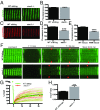
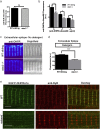
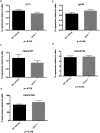

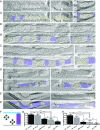
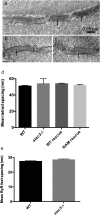

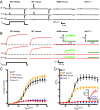
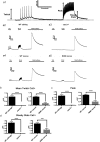


Similar articles
-
Transport of the alpha subunit of the voltage gated L-type calcium channel through the sarcoplasmic reticulum occurs prior to localization to triads and requires the beta subunit but not Stac3 in skeletal muscles.Traffic. 2017 Sep;18(9):622-632. doi: 10.1111/tra.12502. Traffic. 2017. PMID: 28697281 Free PMC article.
-
Stac adaptor proteins regulate trafficking and function of muscle and neuronal L-type Ca2+ channels.Proc Natl Acad Sci U S A. 2015 Jan 13;112(2):602-6. doi: 10.1073/pnas.1423113112. Epub 2014 Dec 29. Proc Natl Acad Sci U S A. 2015. PMID: 25548159 Free PMC article.
-
Stac3 is a component of the excitation-contraction coupling machinery and mutated in Native American myopathy.Nat Commun. 2013;4:1952. doi: 10.1038/ncomms2952. Nat Commun. 2013. PMID: 23736855 Free PMC article.
-
Core skeletal muscle ryanodine receptor calcium release complex.Clin Exp Pharmacol Physiol. 2017 Jan;44(1):3-12. doi: 10.1111/1440-1681.12676. Clin Exp Pharmacol Physiol. 2017. PMID: 27696487 Review.
-
Functional equivalence of dihydropyridine receptor alpha1S and beta1a subunits in triggering excitation-contraction coupling in skeletal muscle.Biol Res. 2004;37(4):565-75. doi: 10.4067/s0716-97602004000400010. Biol Res. 2004. PMID: 15709683 Review.
Cited by
-
De novo reconstitution reveals the proteins required for skeletal muscle voltage-induced Ca2+ release.Proc Natl Acad Sci U S A. 2017 Dec 26;114(52):13822-13827. doi: 10.1073/pnas.1716461115. Epub 2017 Dec 11. Proc Natl Acad Sci U S A. 2017. PMID: 29229815 Free PMC article.
-
STAC3 binding to CaV1.1 II-III loop is nonessential but critically supports skeletal muscle excitation-contraction coupling.JCI Insight. 2025 Aug 8;10(15):e191053. doi: 10.1172/jci.insight.191053. eCollection 2025 Aug 8. JCI Insight. 2025. PMID: 40779452 Free PMC article.
-
Genetically encoded cell-death indicators (GEDI) to detect an early irreversible commitment to neurodegeneration.Nat Commun. 2021 Sep 6;12(1):5284. doi: 10.1038/s41467-021-25549-9. Nat Commun. 2021. PMID: 34489414 Free PMC article.
-
Structural insights into binding of STAC proteins to voltage-gated calcium channels.Proc Natl Acad Sci U S A. 2017 Nov 7;114(45):E9520-E9528. doi: 10.1073/pnas.1708852114. Epub 2017 Oct 23. Proc Natl Acad Sci U S A. 2017. PMID: 29078335 Free PMC article.
-
The binding interactions that maintain excitation-contraction coupling junctions in skeletal muscle.J Gen Physiol. 2019 Apr 1;151(4):593-605. doi: 10.1085/jgp.201812268. Epub 2019 Feb 6. J Gen Physiol. 2019. PMID: 30728215 Free PMC article.
References
-
- Tanabe T, Beam KG, Powell JA, Numa S. Restoration of excitation-contraction coupling and slow calcium current in dysgenic muscle by dihydropyridine receptor complementary DNA. Nature. 1988;336(6195):134–139. - PubMed
-
- Lai FA, Erickson HP, Rousseau E, Liu QY, Meissner G. Purification and reconstitution of the calcium release channel from skeletal muscle. Nature. 1988;331(6154):315–319. - PubMed
Publication types
MeSH terms
Substances
Grants and funding
LinkOut - more resources
Full Text Sources
Other Literature Sources
Medical
Molecular Biology Databases
Research Materials
Miscellaneous

